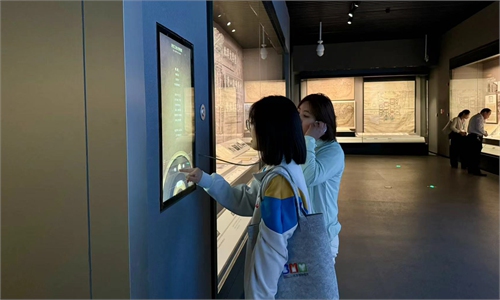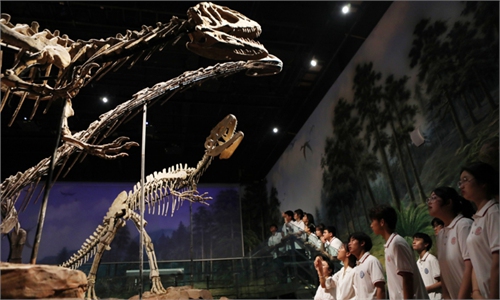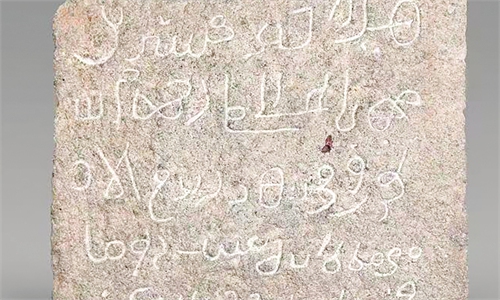ARTS / CULTURE & LEISURE
1.29 billion visitors a year, Chinese museums fulfill IMD’s goal of promoting research, public education
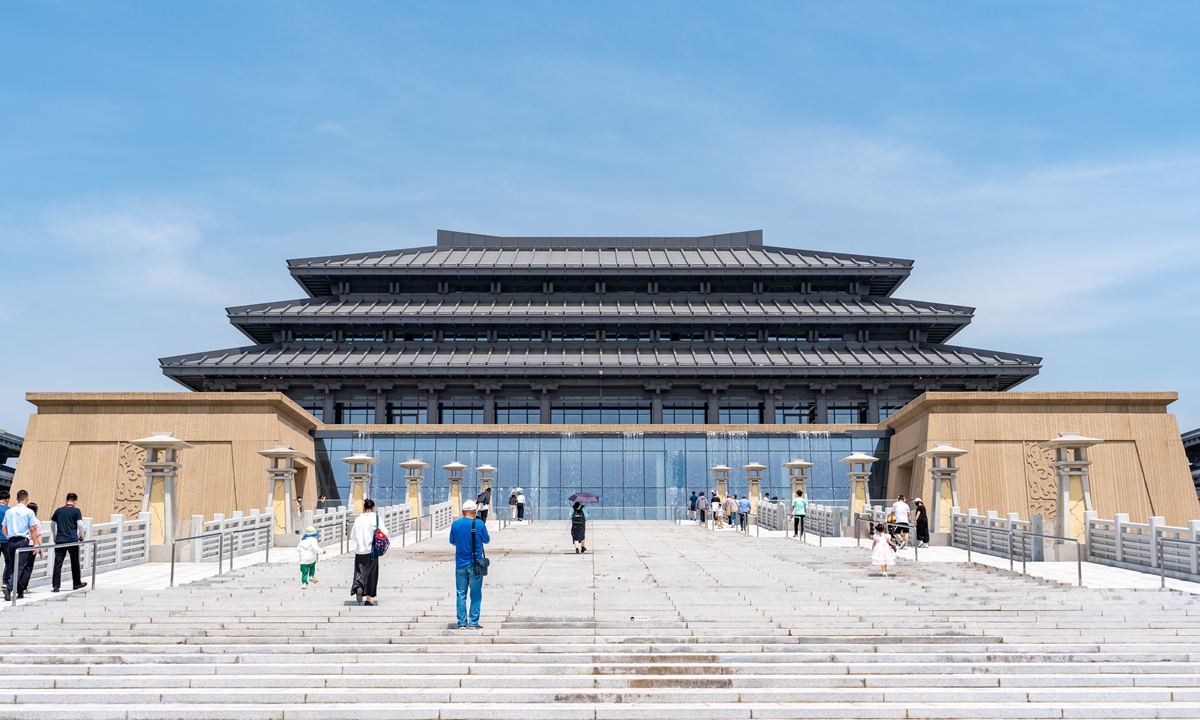
Photo: VCG
Editor's Note:May 18 is a special date because of the key word "museum." Forty-seven years ago, the tradition of International Museum Day (IMD) was established, engaging museums around the world to opine on cultural-social themes like 2024's "Museums for Education and Research."
China, a country boasting 6,833 officially recognized museums, has always been a passionate participant in the global museum discussion. Ever since May 18, 2009, a Chinese museum in the country will be appointed as the main venue hosting a series of events to celebrate IMD. For example, the Qin Han Museum of the Shaanxi History Museum was the 2024 host.
With the aim of exploring how China fulfills IMD's unchanging promise of offering the public open-source cultural knowledge, the Global Times will walk readers through the diverse museum events being held in the country as well as highlight how the country's museums have achieved its "Education and Research" goal with its strategic combinations of "education+ red culture" and "technology + museum experience."
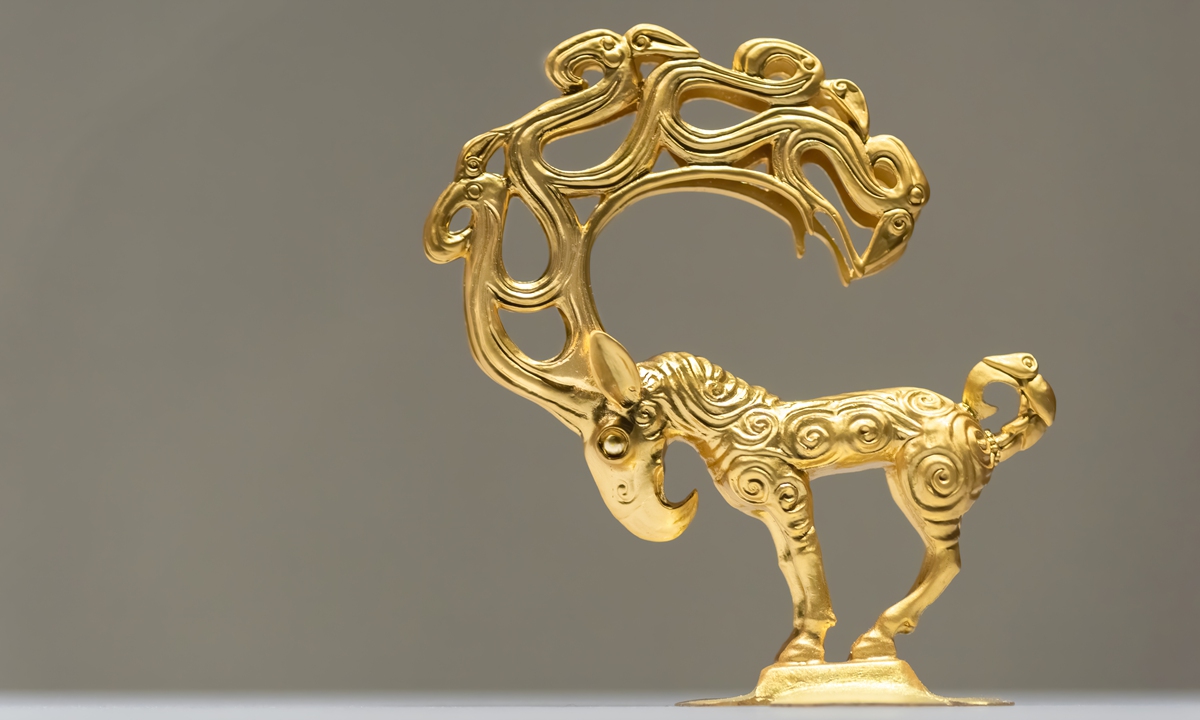
Photo: VCG
On Saturday, coinciding with IMD, the Qin Han Museum of the Shaanxi History Museum in Xi'an, Northwest China's Shaanxi Province, opened for the first time. The main venue for IMD events in China, the museum's main maiden exhibition was major highlight of the day as 90 percent of its relics, including a gold beast statue from the Warring States Period (475BC-221BC), were revealed to the public for the first time.Led by China's National Cultural Heritage Administration (NCHA), celebrations for IMD 2024 were introduced at the museum, including an international Qin-Han history forum, the reveal of Beijing as the next main venue for IMD 2025 events in China, as well as the release of a list of China's newest batch of first-class national museums.
This new batch mainly consists of theme museums like the Exhibition Hall of Evidences of Crime Committed by Unit 731 of the Japanese Imperial Army in Heilongjiang Province. Bei Jiekai, a cultural resource management expert, told the Global Times that this list system shows "China's abundant museum resources," as well as its strategy to "develop niche exhibition institutions nationwide."
In 2023, museums nationwide received more than 1.29 billion visitors. A total of 268 museums were registered over the past year. Meanwhile, at both big- and small-scale exhibition facilities, a total of more than 40,000 exhibitions and 380,000 educational activities were held across the country.
Li Qun, the head of the NCHA and deputy minister of culture and tourism, said that the future construction of museums in China will focus on "rich variety," "diverse exhibitions" and providing the public with more "inclusive cultural resources." He also encouraged museums to enhance their ability to present research.
Events nationwide
"Museums for Education and Research" is the main theme of IMD 2024, which underscores the pivotal role of cultural institutions in providing comprehensive educational experiences. Events inspired by this theme are being carried out in cities like Beijing and provinces such as Jiangsu, Sichuan and Henan.
At the Luoyang Museum in Henan Province, more than 100 artifacts were exhibited depicting how Chinese handicrafts played a major role in cultural exchanges during the Qing Dynasty (1644-1911). A majority of these relics were enamel and porcelain wares historically made in Guangdong Province and exported overseas.
The exhibition, which has been curated to tell the story of cultural exchanges along the ancient Maritime Silk Road, is the result of the Luoyang Museum's research collaboration with the Dongguan Museum.
To better illustrate ancient China's connection to the West for visitors, free lectures addressing Maritime Silk Road exchanges are being held to engage not only adults, but also child audiences who can experience history through paintings and interactive activities.
In Nanjing, Jiangsu Province, the Nanjing Yunjin Brocade Research Institute has launched an exhibition that commemorates the 15th anniversary of Chinese Yunjin brocade becoming a UNESCO intangible cultural heritage (ICH).
Jian Mingwei, the director of the institute, told the Global Times that besides research, ICH needs to be "creatively merged into people's everyday lives through cross-over collaborations and cultural creative products." He emphasized that "educating the public on the importance of ICH" is important to ensure these traditions are inherited.
'Education + red culture'
Museum expert Li Liyang told the Global Times that conducive to China's rich history, "red museums" are now a well-developed sector in the country that fulfills the mission of public patriotism education.
"Revolutionary sites and memorial halls on historical figures and events are becoming hot trends for cultural tourism in China. Many of these sites in provinces like Jiangxi, Sichuan and Shaanxi are crowded. They help the public to see China's development through the presentation of historical facts," Li emphasized.
On Saturday, museums in Sichuan Province and Chongqing Municipality hosted over 300 activities, with a highlight being the Sichuan-Chongqing Red Resources Protection and Inheritance Alliance, which focuses on the legacy of the "Work-Study Movement in France" among other topics.
Tang Xihao, head of the Deng Xiaoping Former Residence Museum, told the Global Times that this year, which commemorates the 105th anniversary of the May Fourth Movement and the 60th anniversary of the establishment of diplomatic relations between China and France, the alliance aims to preserve the historical narrative of the movement, which has played a significant role in educational exchanges between the two nations.
As an important source of talent for the Diligent Work-Frugal Study Movement, the Sichuan-Chongqing region not only contributed to the dissemination of Marxism in China and the establishment of Communist Party of China (CPC) but also nurtured numerous outstanding leaders and revolutionary fighters, including Deng Xiaoping, Chen Yi and Nie Rongzhen.
According to Tang, the alliance, the first of its kind in China, is composed of 16 related museums, memorial halls, and revolutionary sites in the Sichuan-Chongqing region. It aims to facilitate exchange and cooperation, resource sharing, and the promotion of red resource protection.
Xu Xiaoqun, a deputy director of the Revolutionary Relics Department of the Sichuan Provincial Cultural Heritage Administration, told the Global Times that to revitalize revolutionary relics and tell the stories of the CPC, various regions are actively utilizing revolutionary relics to launch a series of "online plus offline" educational activities.
In Sichuan, these efforts include integrating youth research, cultural products promotion, and tourism leisure services.
Moreover, sites like the Zhao Yiman Memorial Hall in Sichuan's Yibin city has been selected as a demonstration base for integrated development of promoting revolutionary culture and socialist advanced culture by the Ministry of Education and the National Culture Heritage Administration (NCHA).
In March 2024, the two sides jointly launched the construction of the national revolutionary relics collaborative research center. Twenty collaborative research institutions were selected to promote the integrated development of revolutionary relics and political education in primary, secondary and tertiary schools. Later on, more red tourism events were promoted across China.
In Beijing and Hebei, the regional cultural heritage bureaus jointly held the opening ceremony of revolutionary cultural relics theme tours in March to commemorate the 75th anniversary of The CPC Central Committee Journey from Xibaipo to Beijing exhibition. Seven important revolutionary sites along the route from Xibaipo to Beijing were connected, showcasing the achievements of the protection and utilization of red cultural relics.
Li Liangqi, director of the Cultural Relics Protection Department of the Beijing Municipal Bureau of Cultural Heritage, told the Global Times connecting relic sites is important to facilitate a comprehensive understanding of revolutionary cultural history, promote revolutionary spirit and educate future generations.
Technology + museum experience
While taking the public back to China's history, museum facilities nationwide, including red sites, are also looking ahead with the goal of taking the public to the "future" through innovative technology that can boost an institution's display and research.
VR and AR technologies have been used to create immersive exhibitions that enable visitors to engage deeply with historical and cultural content through interactive experiences.
The Memorial of the First National Congress of the Communist Party of China in Shanghai has used digital technology to create interactive stories of the Party's founding, Xue Feng, Party committee secretary and curator of the memorial, told the Global Times.
In 2021, exhibits featuring the establishment of the CPC were opened to the public with two major digital exhibitions: The Momentous Event of Pioneering a New Era and City of Glory.
The first exhibition combines virtual characters with real scenes, providing an immersive depiction of the preparation of the CPC' first national congress, commencement, debates, and relocation to a red boat on Nanhu Lake in neighboring Zhejiang Province's Jiaxing city. Meanwhile the second exhibition employs a multimedia digital sand table to present a large-scale model of Shanghai's urban layout in the 1930s.
Digital platforms can further support online exhibitions and educational resources, breaking geographical barriers and providing global access to museum content.
The Heyuan Dinosaur Museum in South China's Guangdong Province has developed an online virtual tour system on its official WeChat account that utilizes digital multimedia display technology to create virtual exhibition halls.
In Suzhou, East China's Jiangsu Province, the Suzhou Bay Digital Art Museum integrates cutting-edge displays and AI algorithms with cultural art to offer a unique digital cultural experience to visitors. In the "Infinity Land" section of the museum, visitors can transcend time and space through AR, 3D projections and interactive touch controls, which allows them to learn about human history while personally engaging in the experience.
The museum also hosts public educational programs, targeting children and families through interactive art installations. On the third floor, there is China's first visual health science education base, which features an innovative and original eye health science exhibition.
At the Sanxingdui Museum in Sichuan Province, digital technologiesy such as high-resolution scanning and 3D modelling techniques are extensively used in exhibitions, conservation and guided tours at the site.
Since 2016, the museum has implemented a digital preservation project, completing high-precision digitization of most of its artifacts and establishing a unified digital resource management system.
"A majority of these cutting-edge displays at Chinese museums are strongly supported by the country's independent innovation," Li told the Global Times.
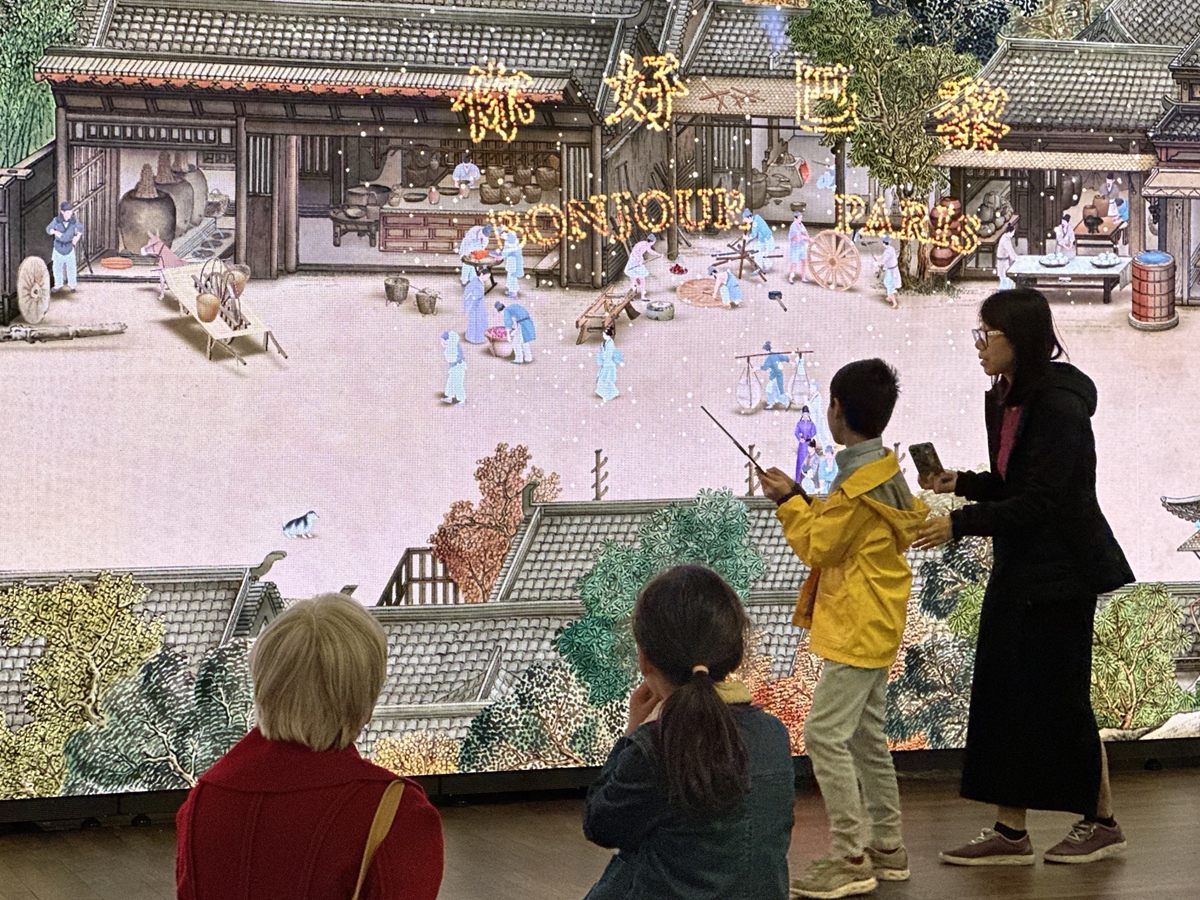
Visitors explore the An Era in Jinling: A Digital Art Exhibition in Paris, France. Photo: Courtesy of Deji Art Museum
Connecting to the worldWhen it comes to China's museums, be they state-owned or private ones, more and more overseas exhibitions and cooperation with international museums are helping people around the world learn about China and Chinese culture.
An Era in Jinling: A Digital Art Exhibition by the Deji Art Museum, which ran from Thursday to Saturday in Paris, enabled visitors to "walk" through the ancient Chinese painting An Era in Jinling, and even interact with the people depicted therein, using only a smart wristband and a mobile phone.
According to Ai Lin, the director of the Deji Art Museum in Nanjing, the handscroll, magnified and projected onto a 110-meter by 3.6-meter screen, depicts a total of 533 figures, 90 animals, and more than two dozen carriages, horses and sedans. Visitors can wander the streets and interact with these figures in real time.
Due to the limited space in Paris, only a part of the screen was displayed, "but the visitors still marveled at the life scenes and city views from as far back as 1,000 years ago," said Ai.
French journalists and visitors wondered why the painting focused on "an ordinary day," instead of historical moments like war or victory. "We told them that only a peaceful and stable life is best," she said, adding that the exhibition allows French people to get to know about Chinese lifestyles and the hope for a steady and prosperous life.
From families and young people to a French professor, the digital exhibition enlightened and piqued their interest in Jinling, now known as Nanjing, a 2,500-year-old Chinese city near the Yangtze River.
"I think that is the charm and magic of exchanges and culture. We share the same view on beauty, peace and life," said Ai, who also held talks with a number of French museum directors on potential collaboration.
One of the most important missions of museums is education Ai noted.
"We all hope to spread culture, boost exchanges and increase people's awareness. Toward that goal, we have so much in common that we can do," Ai remarked.
